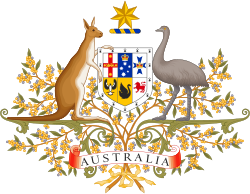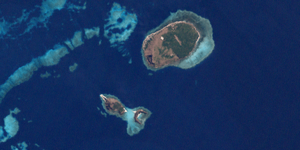Mabo v Queensland (No 2) facts for kids
Quick facts for kids Mabo v Queensland (No 2) |
|
|---|---|
 |
|
| Court | High Court of Australia |
| Full case name | Mabo and Others v Queensland (No. 2) |
| Argued | 28-31 May 1992 |
| Decided | 3 June 1992 |
| Case opinions | |
| Native title exists and is recognised at common law in Australia | |
| Court membership | |
| Judge(s) sitting | Mason CJ, Brennan, Deane, Dawson, Toohey, Gaudron & McHugh JJ |
| Case opinions | |
| Majority | Mason CJ, Brennan, Deane, Toohey, Gaudron & McHugh JJ |
| Dissent | Dawson J |
Mabo v Queensland (No 2) (often called Mabo) was a very important decision by the High Court of Australia. It was decided on 3 June 1992. This case was started by Eddie Mabo against the State of Queensland.
The case is famous because it was the first time Australian law officially recognised that Indigenous Australians had land rights before British settlement. These rights came from their traditional customs and laws. The court said these rights were never fully lost when Australia was colonised.
The Mabo decision is very important for Aboriginal and Torres Strait Islander people. It said that Australia was not "terra nullius" (meaning "nobody's land") when the British arrived. This idea had been used to say that Indigenous people had no land rights.
Australia's Prime Minister at the time, Paul Keating, praised the decision. He said it "establishes a fundamental truth, and lays the basis for justice." However, some groups, like the government of Western Australia and mining companies, did not like the decision.
The idea of native title was later made into a law. This law was called the Native Title Act 1993. It helped Indigenous people claim their land rights in court.
Contents
Why the Mabo Case Happened
This case was about land on the Murray Islands Group. These islands include Murray Island (also known as Mer Island), Waua Islet, and Daua Island. The Meriam people, who are Torres Strait Islanders, have lived on these islands for hundreds of years.
Meriam People's Land Laws
For a very long time, the Meriam people have had their own laws about land. These laws are called Malo's Law. They believe these laws came from their religion. Under Malo's Law, all land on Mer Island is owned by different Meriam families. There is no idea of public land.
Land is usually owned by the oldest son for a family group. This means land is owned both by individuals and by the community. Unlike Western laws, Meriam land ownership is mostly passed down by talking, not by writing. However, they also have some written records now to help with modern laws.
The Meriam people believe they own the land, but also that the land owns them. This means they have a duty to care for the land. They must share it with their family and protect it for future generations.
In 1871, missionaries came to the Torres Strait. Many Torres Strait Islanders, including those on Mer Island, became Christians. But this did not replace their old traditions. Instead, Malo's Law and other customs were blended with Christianity.
In 1879, the State of Queensland officially took control of the islands.
Legal History Before Mabo
Before the Mabo case, Australian law did not recognise the land rights of Indigenous Australians. In the 1970s, there was a case called Milirrpum v Nabalco Pty Ltd. In that case, the court said that native title did not exist in Australia.
In 1982, Eddie Mabo and other plaintiffs asked the High Court to say that the Meriam people had land rights on Murray Island. They said these rights came from their local customs and their long-term use of the land. The Queensland government argued that native title had never existed. They also said that if it did, it was removed by a law passed in 1910.
Before the court made its decision, the Queensland government tried to pass a law. This law would have taken away any native title rights on the Murray Islands. But this law was challenged in an earlier case, Mabo v Queensland (No 1). The court said that Queensland's law was not fair. It went against a law called the Racial Discrimination Act.
The Court's Decision
The High Court decided that native title rights were part of Australia's common law. These rights came from Indigenous laws and customs. They did not come from a grant by the British Crown.
However, the court also said that these rights were not absolute. They could be taken away by state or federal laws. They could also be lost if the government gave land rights to others that went against native title. The court also said that when the British Crown took control of the land, it did not automatically end native title.
Most of the High Court judges agreed on these points:
- The idea of "terra nullius" (empty land) did not apply to Australia when the British settled.
- The Crown gained control over the land when the British settled.
- Native title is a real part of Australia's common law.
- Native title comes from the traditional customs and laws of Indigenous groups.
- The exact nature of native title rights depends on these ongoing traditional laws.
- Native title could be ended by a government action that went against it.
What is Terra Nullius?
The court talked a lot about "terra nullius." This is an international law idea meaning "no one's land." It refers to land that is empty or not controlled by any state. Such land can be claimed by another state.
The court also discussed a similar common law idea. This idea said that "desert and uncultivated land" could be claimed by Britain. This included land without settled people or laws. When Britain settled such land, English laws would apply.
Most of the court rejected the idea that "terra nullius" stopped the recognition of Indigenous land rights. They said these rights existed when the British settled New South Wales.
Why Mabo Was So Important
The Mabo case caused a lot of discussion and debate. Paul Keating, who was the Prime Minister of Australia at the time, praised the decision. He said it "establishes a fundamental truth, and lays the basis for justice." But Richard Court, the Premier of Western Australia, did not agree. Many mining and farming groups also shared his concerns.
How Native Title Developed
The Mabo decision led to the legal idea of native title. This allowed more court cases for First Nations land rights. The idea of native title was later made into a law by the Keating Government. This law was called the Native Title Act 1993.
Recognising native title brought up many new legal questions. These included questions about how valid land titles were if they went against the Racial Discrimination Act 1975. People also wondered how future land development would work with native title.
Because of the Mabo judgment, the Keating Government created the Native Title Act 1993. This law set up the National Native Title Tribunal. This group helps decide if native title exists on land. The law was later changed by the Howard Government after another important case, the Wik decision.
Legal Test for First Nations Identity
In his judgment, Justice Brennan set out a three-part test. This test helps decide if someone is recognised as a First Nations Australian. He wrote that being a member of Indigenous people depends on:
- Being a biological descendant of Indigenous people.
- Both the person and the elders (or other respected people) of that group agreeing on their membership.
This test has been very important in later court cases.
After the Mabo Decision
Ten years after the Mabo decision, Eddie Mabo's wife, Bonita Mabo, said there were still issues about land on Mer Island.
On 1 February 2014, the traditional owners of land on Badu Island received full ownership of their land. This was an act by the Queensland Government. An agreement about Indigenous land use was signed on 7 July 2014.
Mabo's Legacy
Mabo Day is an official holiday in the Torres Shire. It is celebrated on 3 June. This day is also during National Reconciliation Week in Australia.
The Mabo case was mentioned in the 1997 Australian comedy film The Castle. It was seen as a symbol of legal fairness. A famous line from the movie is: "In summing up, it’s the Constitution, it’s Mabo, it’s justice, it’s law, it’s the vibe."
In 2009, during the Q150 celebrations, the Mabo High Court decision was named one of the Q150 Icons of Queensland. It was called a "Defining Moment" for its importance.
A TV film called Mabo was made in 2012. It showed the story of the case. It also focused on how the case affected Eddie Mabo and his family.
See also
 In Spanish: Caso Mabo contra Queensland (No 2) para niños
In Spanish: Caso Mabo contra Queensland (No 2) para niños
- Native title in Australia
- Aboriginal title
- Indigenous land rights in Australia
- History of Indigenous Australians
- List of Australian native title court cases
- Love v Commonwealth
- Milirrpum v Nabalco Pty Ltd
- Mabo v Queensland (No 1)
- Native Title Act 1993
- Wik Peoples v Queensland
- Yorta Yorta v Victoria
- Land tenure
- Allodial title


